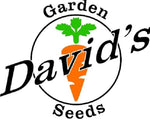Three Sisters Garden

A Three Sisters Garden is a Native American idea based on a story of three vegetables that were staples of the ancient Native American diet. The three vegetables are corn, beans, and squash (including pumpkins). This is Companion Planting, done hundreds of years ago, long before we were the United States of America. David's Garden Seeds® has a set for purchase. You can also pick and choose your own variety of corn, beans, and pumpkins or squash.
The Native American legend says that there were three sisters. The first one was tall with yellow hair and a green wrap named Corn.
The second could only crawl and stayed close to Corn. Her name was Bean.

Sweet Corn stalks growing in the Texas heat. You can see the ears at the bottom of the photo.

Fortex Pole Beans are delicious!

Yellow Crookneck Summer Squash is our most popular summer squash, but any squash, including pumpkins, will work.

Mammoth Grey Stripe Sunflower is pictured. The sunflower is the fourth sister used by Native Americans.
The third sister wore yellow and sprawled out all over the place. Her name was Squash. The three girls loved each other dearly and were always together.
Make Your Own Three Sisters Garden
Now you can plant these three staples in your garden in much the same way that the Native Americans have for hundreds of years.
First, choose a place in your yard that gets six to eight hours of direct sunlight every day. Till the soil and add manure or fertilizer and mix it in well. Native Americans would put raw fish heads in the holes when they planted their seeds for fertilizer.
In the center of your space, outline a circle 18 inches in diameter in the dirt. Then make a mound in the circle that is six inches high. Plant four corn seeds, any variety, six inches apart on the top of the 18 inch mound. Cover the top of the mound with a thin layer of mulch to help keep moisture in.
Once the four corn seedlings start to come up, get your bean seeds ready. When the corn plants are four inches high, and not until they are four inches high, plant four pole beans or four runner beans on the sides of the mound, spaced about the same distance apart. If you plant the beans too soon, they will take over the corn and ruin it.
On the same day the beans are planted, plant the squash (or pumpkins as they are a part of the squash family) as well, around the 18 inch mound. Make four small mounds around the 18 inch mound, even with the bean seeds and plant one squash seed in each small mound. This can be any plant in the squash family, including pumpkins and zucchini.
-----------------------------------------------------------------------------------------------------------
The following five photos are from one of our customers who bought our Three Sisters set and planted them. Credit for the photos goes to Cary Mannaberg, Temple B'nai Israel in Kalamazoo, Michigan for their religious school. Cary says he is looking forward to teaching the children about this growing method and will cook the vegetables this fall in a delicious succotash. Sounds great! Thank you, Cary for the photos.





-----------------------------------------------------------------------------------------------------------
Three Sisters Garden Bonus!
There Is A Fourth Sister!

Native Americans also planted sunflowers as the fourth sister in their gardens, along with the Three Sisters. Pictured above is our number one selling seed, The Mammoth Grey Stripe Sunflower. We grow them every year. They are pretty and you can eat the harvested seeds once you roast them.
If you choose to plant sunflowers, put them on the north side of the garden because they will grow tall. When they do, they will not block the sun from the other plants if they are planted on the north side of the grouping of the other plants.
Of course, you can repeat the Three Sisters Garden in several spots in your yard if four plants of each won't be enough to feed your family. You may have as many as you want and can fit of the plant groupings in your backyard garden.
The corn stalks grow tall and the beans will grow up the stalks. The corn will support the bean vines so you don't need to worry about poles for the beans to climb. The squash or pumpkin vines spread out on the ground and help keep moisture in the ground. They also help to keep weeds from growing on the ground by blocking sunlight on the ground, preventing weeds. The beans add nitrogen to the ground, which the corn needs to grow properly.







What time of the year are the three sisters planted?
Leave a comment